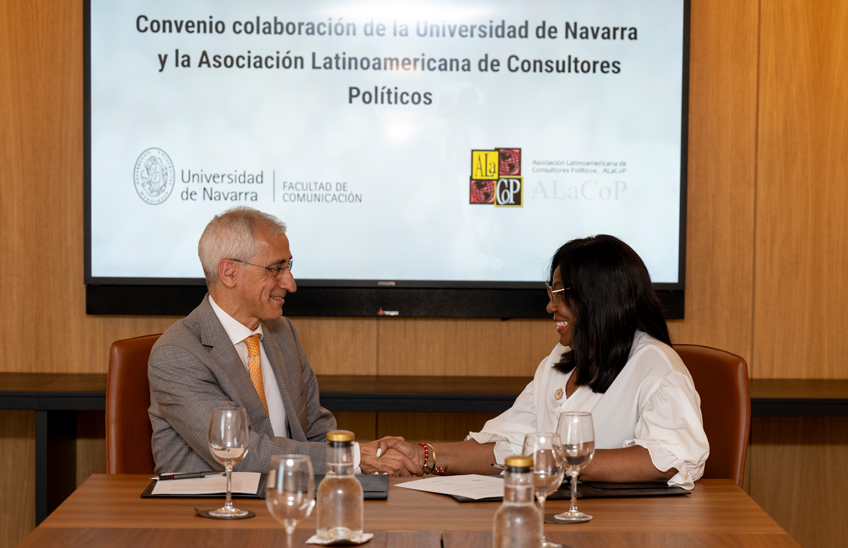Digital subscriptions grow despite declining interest and trust in the news

FotoManuelCastells/The five researchers from the Spanish chapter of the Digital News Report who participated in report: Samuel Negredo, Avelino Amoedo, Alfonso Vara-Miguel, Elsa Moreno and Jürg Kaufmann.
16 | 06 | 2022
- One in eight users (11.7%) pay to access media on the Internet and 42% of them do so on a recurring basis, according to the report Digital News Report Spain 2022 of the University of Madrid.
- For the first time in the nine editions of survey, those who distrust the news (39%) outnumber those who trust (32%); and 35% often or sometimes avoid getting information.
Although the percentage of Spaniards who paid for digital information is similar to last year (11.7%), 42% of those who did so opted for a regular payment or standard subscription (eleven points more than in 2020), and 31% chose a joint subscription to a package of print and/or digital media (eight points more than two years ago).
These are some of the conclusions of the report Digital News Report Spain 2022The Digital News Report Spain 2022, prepared by researchers from the School of Communication of the University of Navarra, based on a survey carried out by YouGov at partnership with high school Reuters of the University of Oxford.
Since 2019, the main news groups have opted for a freemium strategy, in which the most exclusive and differentiated content is no longer free. Thus, from agreement with the data declared by the industry itself collected by the authors of this report (May 2022), the Spanish market has more than 775,000 subscribers, 94% more than a year ago. These figures contrast with the fact that the majority of citizens remain highly resistant to paying for print or digital news: two out of three respondents never pay for information (67%).
Along with payment for news, registration for access to the media is also beginning to emerge in Spain, with citizens offering some of their personal data data. 24% of those surveyed said that they had registered with a news media outlet in the last year, compared with 70% who had not. This is lower than the average figure of 28% reported in the 22 countries where this issue has been analysed.
Traditional brands, especially newspapers and television channels, continue to be the most consulted online, and enjoy a higher frequency of consumption than digital native media. Three of the latter are once again among the top ten most consulted weekly in Spain, although they have room for improvement in terms of loyalty (use three or more days a week).
In contrast to this traditional brand-loyal consumer, who accesses news through their apps or shortcuts (50%), there is a larger and growing proportion who do so indirectly through the algorithms of social media platforms and networks (62%), for whom the weight of the brand is diluted.
Among the most worrying data , the report sample shows that the Spanish population's interest and trust in the news are the lowest in recent years. For the first time in nine editions, the percentage of people who do not trust the news in general (39%) exceeds those who do (32%). The figure has been falling since 2017, when more than half of respondents said they trusted the media (51%) and only 24% were sceptical. In addition, for the first time, none of the thirteen leading news brands surveyed has the trust of the majority of those who know them.
One of the reasons that may explain the loss of trust in the news, according to the study, is the widespread perception among respondents that the Spanish media are not independent from political or business groups. Only 13% of Spanish users trust the independence of the media from politicians, and 15% from commercial influences, five points less than in 2017. Spain is the second European country with the worst public perception of the independence of its media companies from political pressures (only behind Greece and sharing place with Italy) and from business pressures.
In terms of interest, the percentage of Spaniards very interested in news has fallen from 85% in 2015 to 55% today. Likewise, the percentage of those uninterested in the news has increased tenfold over these eight years: from 1% to 11%.
As a result, the percentage of Spaniards who actively avoid being informed has increased: one in three (35%) often or sometimes avoids being informed, and 10% do so frequently. The three main reasons for doing so are weariness with excessive coverage of topics such as politics or Covid-19 (44%), the negative influence that news has on their mood (30%) and distrust of information (28%).
Mobile and participatory users
In addition, 75% regularly use the smart mobile to consume news, more than twice as many as use a computer (36%). Fifty-four percent of respondents use a smart TV device, and one in four adults (25%) use it to get information via the internet and apps on this large connected screen.
The Spanish digital news audience is, once again this year, one of the most participative (69%) of the 46 markets in which the survey is conducted. Specifically, half of them do it regularly (ten points more than the international average), especially through instant messaging applications such as WhatsApp, Facebook Messenger or Telegram (35%).
Six in ten respondents (63%) were interested in local or regional news at the beginning of 2022, ahead of coronavirus news (47%), international news (46%), culture (44%), science and technology (42%), and politics (41%). Only 11% say they do not pay attention to any source news on climate change: they prefer to follow scientists, experts and academics (46%), followed by the media (37%). In addition, almost half of respondents (49%) believe that media coverage should be clearly positioned in favour of action to combat climate change.
The survey Digital News Report and the report Digital News Report Spain
Digital News Report is a project of the high school Reuters for the Study of Journalism of the University of Oxford, based on a survey conducted by YouGov. The authors of the report Digital News Report Spain 2022 and responsible for the interpretation of these data are researchers at School of Communication of the University of Navarra, sponsor and partner academic since the 2014 edition.
sample The survey is based on an online panel of more than two thousand people (N = 2028 in this edition), representative of the adult population connected to the internet, based on various demographic, socio-economic and territorial factors. The work fieldwork in Spain was carried out between 17 January and 14 February 2022.
The report Digital News Report Spain 2022, with dozens of graphics, is available openly available for enquiry and attribution at https://www.digitalnewsreport.es.
The study is part of the results of the project IBERIFIER, co-financed by the European Union, in the call CEF-TC-2020-2 (European Digital average Observatory), under the agreement issue INEA/CEF/ICT/A20202072381931, Action 2020-EU-IA-0252.



